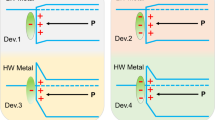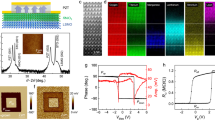Abstract
The development of ultrathin ferroelectric capacitors for use in memory applications has been hampered by depolarization effects arising from the electrode–film interfaces. These can be characterized in terms of a reduced interface capacitance, or equivalently an ‘effective dead layer’ in contact with the electrode. Here, by performing first-principles calculations on four capacitor structures based on BaTiO3 and PbTiO3, we determine the intrinsic interfacial effects responsible for destabilizing the ferroelectric state in ultrathin-film devices. Although it has been widely believed that these are governed by the electronic screening properties at the interface, we show that they also depend crucially on the local chemical environment through the force constants of the metal oxide bonds. In particular, in the case of interfaces formed between AO-terminated perovskites and simple metals, we demonstrate a novel mechanism of interfacial ferroelectricity that produces an overall enhancement of the ferroelectric instability of the film, rather than its suppression as is usually assumed. The resulting ‘negative dead layer’ suggests a route to thin-film ferroelectric devices that are free of deleterious size effects.
This is a preview of subscription content, access via your institution
Access options
Subscribe to this journal
Receive 12 print issues and online access
$259.00 per year
only $21.58 per issue
Buy this article
- Purchase on Springer Link
- Instant access to full article PDF
Prices may be subject to local taxes which are calculated during checkout





Similar content being viewed by others
References
Dawber, M., Rabe, K. M. & Scott, J. F. Physics of thin-film ferroelectric oxides. Rev. Mod. Phys. 77, 1083–1130 (2005).
Hwang, C. S. Thickness-dependent dielectric constant of (Ba,Sr)TiO3 thin films with Pt or conducting oxide electrodes. J. Appl. Phys. 92, 432–437 (2002).
Plonka, R., Dittmann, R., Pertsev, N. A., Vasco, E. & Waser, R. Impact of the top-electrode material on the permittivity of single-crystalline Ba0.7Sr0.3TiO3 thin films. Appl. Phys. Lett. 86, 202908 (2005).
Kim, D. J. et al. Polarization relaxation induced by a depolarization field in ultrathin ferroelectric BaTiO3 capacitors. Phys. Rev. Lett. 95, 237602 (2005).
Junquera, J. & Ghosez, P. First-principles study of ferroelectric oxide epitaxial thin films and superlattices: Role of the mechanical and electrical boundary conditions. J. Comput. Theor. Nanosci. 5, 2071–2088 (2008).
Junquera, J. & Ghosez, P. Critical thickness for ferroelectricity in perovskite ultrathin films. Nature 422, 506–509 (2003).
Pertsev, N. A., Dittmann, R., Plonka, R. & Waser, R. Thickness dependence of the intrinsic dielectric response and apparent interfacial capacitance in ferroelectric thin films. J. Appl. Phys. 86, 202908 (2005).
Black, C. T. & Welser, J. J. Electric-field penetration into metals: Consequences for high-dielectric constant capacitors. IEEE Trans. Electron Devices 46, 776–780 (1999).
Tagantsev, A. K. & Gerra, G. Interface-induced phenomena in polarization response of ferroelectric thin films. J. Appl. Phys. 100, 051607 (2006).
Cohen, R. E. Periodic slab LAPW computations for ferroelectric BaTiO3 . J. Phys. Chem. Sol. 57, 1393–1396 (1996).
Cohen, R. E. Surface effects in ferroelectrics: Periodic slab computations for BaTiO3 . Ferroelectrics 194, 323–342 (1997).
Rao, F. Y., Kim, M. Y., Freeman, A. J., Tang, S. P. & Anthony, M. Structural and electronic properties of transition-metal/BaTiO3(001) interfaces. Phys. Rev. B 55, 13953–13960 (1997).
Rabe, K. M. Theoretical investigations of epitaxial strain effects in ferroelectric oxide thin films and superlattices. Curr. Opin. Solid State Mater. Sci. 9, 122–127 (2005).
Ederer, C. & Spaldin, N. A. Effect of epitaxial strain on the spontaneous polarization of thin film ferroelectrics. Phys. Rev. Lett. 95, 257601 (2005).
Sai, N., Kolpak, A. M. & Rappe, A. M. Ferroelectricity in ultrathin perovskite films. Phys. Rev. B 72, 020101(R) (2005).
Umeno, Y., Meyer, B., Elsässer, C. & Gumbsch, P. Ab initio study of the critical thickness for ferroelectricity in ultrathin Pt/PbTiO3/Pt films. Phys. Rev. B 74, 060101(R) (2006).
Gerra, G., Tagantsev, A. K., Setter, N. & Parlinski, K. Ionic polarizability of conductive metal oxides and critical thickness for ferroelectricity in BaTiO3 . Phys. Rev. Lett. 96, 107603 (2006).
Gerra, G., Tagantsev, A. K. & Setter, N. Ferroelectricity in asymmetric metal–ferroelectric–metal heterostructures: A combined first-principles–phenomenological approach. Phys. Rev. Lett. 98, 207601 (2007).
Stengel, M. & Spaldin, N. A. Ab-initio theory of metal–insulator interfaces in a finite electric field. Phys. Rev. B 75, 205121 (2007).
Stengel, M., Spaldin, N. A. & Vanderbilt, D. Electric displacement as the fundamental variable in electronic-structure calculations. Nature Phys. 5, 304–308 (2009).
Blöchl, P. E. Projector augmented-wave method. Phys. Rev. B 50, 17953–17979 (1994).
Stengel, M. & Spaldin, N. A. Origin of the dielectric dead layer in nanoscale capacitors. Nature 443, 679–682 (2006).
Choi, W. S. et al. Dielectric constants of Ir, Ru, Pt, and IrO2: Contributions from bound charges. Phys. Rev. B 74, 205117 (2006).
Ghosez, P., Michenaud, J.-P. & Gonze, X. Dynamical atomic charges: The case of ABO3 compounds. Phys. Rev. B 58, 6224–6239 (1998).
Antons, A., Neaton, J. B., Rabe, K. M. & Vanderbilt, D. Tunability of the dielectric response of epitaxially strained SrTiO3 from first-principles. Phys. Rev. B 71, 024102 (2005).
Giustino, F. & Pasquarello, A. Infrared spectra at surfaces and interfaces from first principles: Evolution of the spectra across the Si(100)–SiO2 interface. Phys. Rev. Lett. 95, 187402 (2005).
Wu, X., Stengel, M., Rabe, K. M. & Vanderbilt, D. Predicting polarization and nonlinear dielectric response of arbitrary perovskite superlattice sequences. Phys. Rev. Lett. 101, 087601 (2008).
Seriani, N., Jin, Z., Pompe, W. & Colombi Ciacchi, L. Density functional theory study of platinum oxides: From infinite crystals to nanoscopic particles. Phys. Rev. B 76, 155421 (2007).
Saad, M. M. et al. Intrinsic dielectric response in ferroelectric nano-capacitors. J. Phys. Condens. Matter 16, L451–L456 (2004).
Tilley, D. R. & Zeks, B. Landau theory of phase transitions in thick films. Solid State Commun. 49, 823–827 (1984).
Ghosez, P. & Rabe, K. M. Microscopic model of ferroelectricity in stress-free PbTiO3 ultrathin films. Appl. Phys. Lett. 76, 2767–2769 (2000).
Giustino, F. & Pasquarello, A. Theory of atomic-scale dielectric permittivity at insulator interfaces. Phys. Rev. B 71, 144104 (2005).
Acknowledgements
This work was supported by the Department of Energy SciDac programme on ‘Quantum simulations of materials and nanostructures’, grant number DE-FC02-06ER25794 (M.S. and N.A.S.), and by ONR grant N00014-05-1-0054 (D.V.). Calculations were carried out at the San Diego Supercomputer Center and at the National Center for Supercomputer Applications.
Author information
Authors and Affiliations
Corresponding author
Rights and permissions
About this article
Cite this article
Stengel, M., Vanderbilt, D. & Spaldin, N. Enhancement of ferroelectricity at metal–oxide interfaces. Nature Mater 8, 392–397 (2009). https://doi.org/10.1038/nmat2429
Received:
Accepted:
Published:
Issue Date:
DOI: https://doi.org/10.1038/nmat2429



